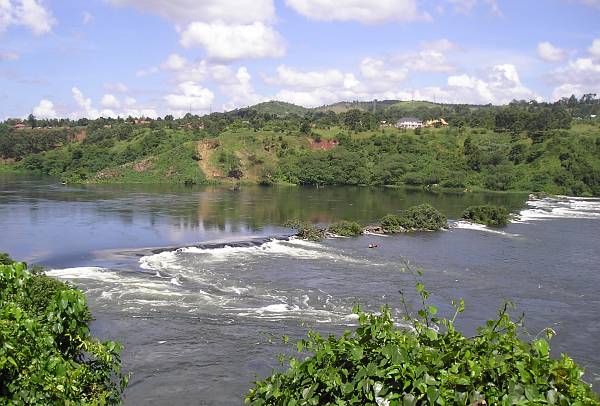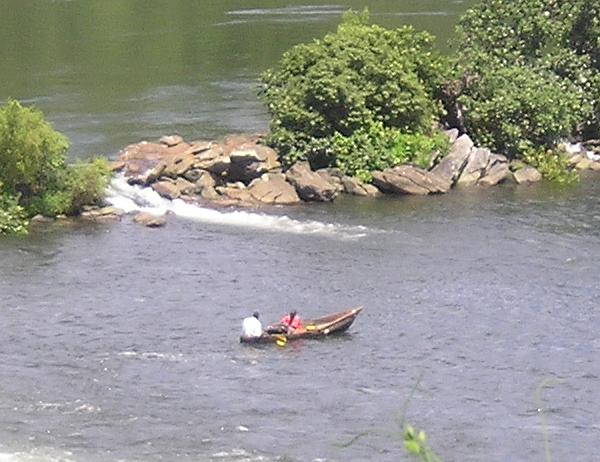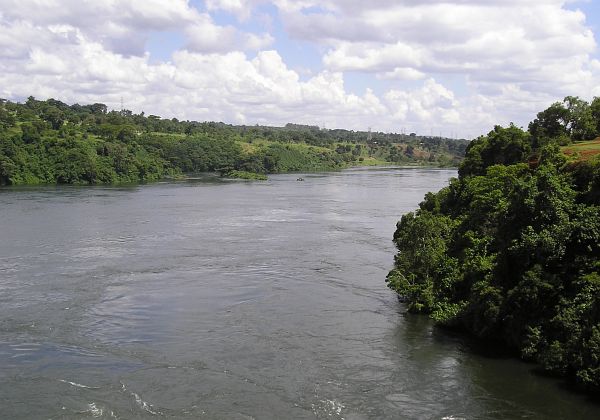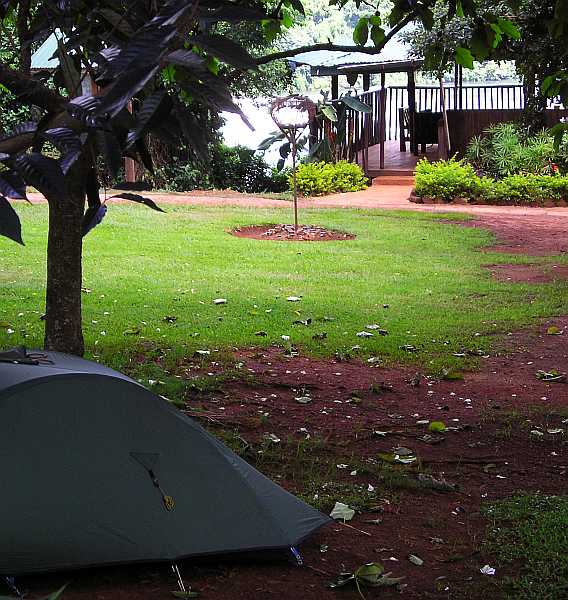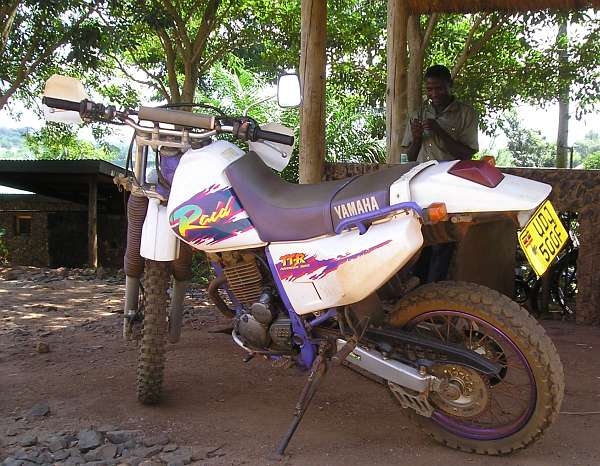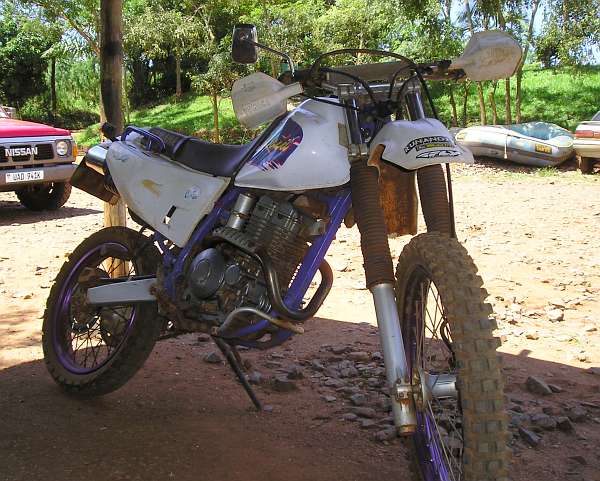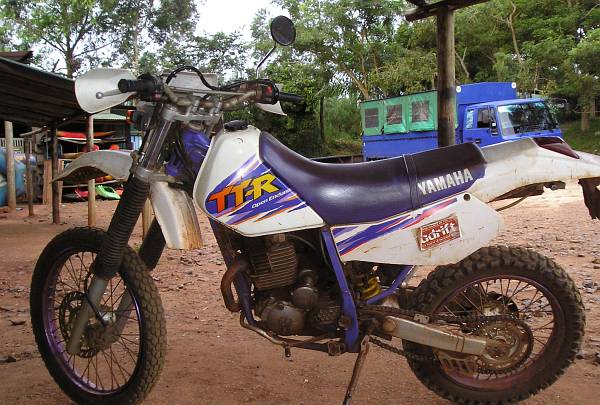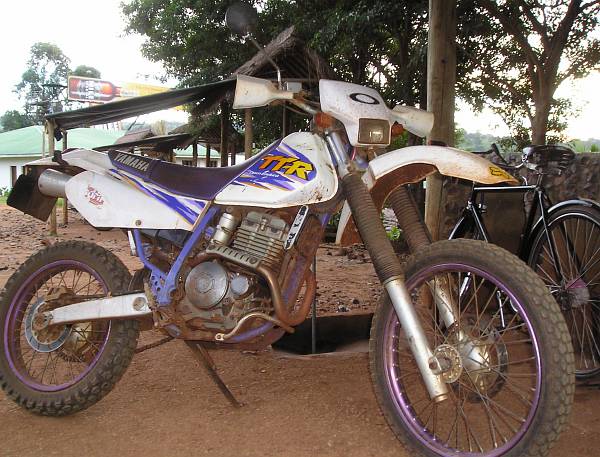Uganda
Crossed the border into Uganda yesterday, all straightforward. But difficult to get used to all the zeros on the money. About 2700 shillings in a pound. I lived almost half my life with twenty shillings in a pound. It doesn't matter how often you hear "Eleven thousand two hundred shillings," - when the word "shillings" reaches your ear, your brain is immediately unable to process any number higher than twenty. A bit of a problem.
The corridor between the border and Jinja, a big resort area, looks fairly prosperous compared with the more down-to-earth towns in western Kenya.
Raj at the Naiberi camp recommended the Adrift river resort in Jinja, so here I am. And so far (one campsite) camping is cheaper than in Kenya. Unless I've got that shillings-in-the-pound bit all wrong.
The road all the way from Nairobi, and from Mombasa further east, roughly follows the line of the old narrow-gauge Kenya-Uganda railway built by the British, mainly with Indian labour. Hence there are lots of Indian influences, businesses and residents in Kenya. The line is still in use, for freight and passengers, but I've yet to see a train on it. Even though the road to here from Eldoret crosses it at many places. Jinja Station is not far from here.
Anyway, in preparation for the awful joke below, it's called The Central Line. Which I used to live close to, and play and travel on, in my schooldays (the London Central Line, that is).
So here in Jinja we have an even bigger landmark that seems only to make any Londoners here a touch homesick.
The Victoria Line.
And here it is:
Ooops ....... Sorry - that should be The Victoria Nile.
(Those 'N' ald 'L' keys anways get mixed up).
These are the Bujagali Falls pictured from the campsite, and this is the start of the mighty Nile River.
Well, the actual start is the point where it leaves lake Victoria about a mile south of here. Until the river leaves Uganda its name is The Victoria Nile.
The Mediterranean and Europe are thataway.
On my way to Kampala, maybe tomorrow, I'll attempt a photo at the actual start. There's a car park there but I suspect it will be so full of hawkers that any photography will be impossible. We'll see.
It's hotter here than the high plateaux of Kenya, and they say the rains are finishing. But already I've heard stories about the road conditions further west. There are no overlanders here, it's an 'adventure' stop-over, people come here for river rafting and bungy jumping. (Not me).
But there was an English couple here yesterday who live and work in a town in the north west, who said the dirt road conditions seem to be controlled by the rains and the sugar cane harvest. (There were three miles of dirt to get here, but no sugar cane).
"The cane is harvested as soon as the rains stop and the dirt roads are all mud. So they use special vehicles with massive balloon tyres. These carve deep ruts in the roads, the width of the tyres, and as deep as they sink into the mud when fully loaded," they told me.
"When the roads dry out the Town Halls are supposed to re-grade all the roads, but they rarely do. They wait until all the villages and businesses along the roads are shouting so loud (or have paid enough money) that they can't be ignore any longer. We couldn't drive here in our car - if we tried the engine would rest on the ridge between the ruts and the wheels would be out in the open air a long way from the ground. So we came by bus which can just about manage the journey."
"On second thoughts, you could just ride in a single rut, so you'd be OK - maybe....."
So there's a lot of research and dipping of toes in water needed for this route to Lake Malawi.
My next stop will be an overlanders' camp in Kampala where I hope to meet a few travellers coming the other way. And also spending time on the internet studying Google Earth and Tracks4Africa, an African GPS database and overlay to Google Earth.
Whatever, I have to continue with the firm idea that I may return all the way back to Nairobi again. But then I get to see everything twice.
An illustration of that was at the border, leaving Kenya. They put your name and details in a big book and ask "How long will you be in Uganda, roughly?"
Then they enter "one month" under "expected return date."(!)
Just so they know when to expect you.
(If you're unable to continue, for whatever reason, through to central Tanzania, then the only option is to return to Kenya, as the borders into Congo are generally closed to foreign vehicles - they know, you know...)
Anyway, this place is OK, but I couldn't put the tent in a place to get a proper view of the Nile. The sun is strong and hot so shade dictates where you pitch it. But I just got a photo of tent and Nile (just about) in the same frame.
Bujagali Falls just visible through gap between trees and bar terrace.
A funny thing happened on the way here, people started commenting on the amount of luggage I have on board. It started in Bungoma. Maybe they're not used to seeing loaded foreign bikes on long journeys.
Certainly, when people ask "Where did you start?" and I reply, "England," there's a definite opening of the eyes and dropping of jaw. That hasn't really happened before. In other places on the 'main route' you normally get a knowing nod, or even, "Ah, like Long Way Down."
And the strange thing is, these people often see motorbikes on their own roads in their own town, carrying four people with no problem at all.
Then when they ask, "How long has it taken?" and you answer "Eight months," the jaw definitely hits the ground.
So I am studying the luggage situation again determined to get rid of more stuff. It would certainly be a good thing to do, so we'll see.
There was an exception to all that here at the campsite.
I saw this bike parked by the reception.
Wot!!!!! Beau's got here before me!! All the way from Eastbourne! HOW did he do THAT?
(But see note below)
This place is run by New Zealanders (the experts on bungy jumping and white-water-rafting) and this TTR250 is owned by the Jump Marshal.
So when he saw my bike he thought it completely unremarkable that I'd arrived here from London, knowing how good they are.
But note: A funny thing happened when I went to take that photo just now.
All the Kiwis have left for now, taking customers down river for the rafting. The bike that I saw when I arrived was exactly the same as Beau's. But this one has no oil cooler, and the tank is a different colour. So it isn't the Jump Marshal's, there must be two of them here! I must check that out when the staff return.
(Just to explain, the internet here is pretty handy, so I could nip out and take that photo while writing up this posting).
............. Time passes, black clouds approach, so I popped up to where my bike is parked to tie the cover down (the wind blows fairly hard when it rains around here) and Beau's look-alike is back. So here's a photo, the bike I saw when I first arrived:
Lastly, except for that last bit of dirt road, the route here all the way from Bungoma was tarmac, but that isn't the whole story.
I'd already heard about the Kenyan melting roads as they drop down into the hotter region towards Uganda. But it was amazing - if not a bit difficult as well.
There are no potholes. But in the hot weather the tarmac softens sufficiently for the wheels of the convoys of heavy trucks to form deep ruts. So deep that some cars have difficulty keeping their wheels in contact with the road as the ridge between the ruts lifts up the suspension. Consequently cars drive all over the road or the shoulder, anywhere to avoid the ruts. So you have to avoid them.
But also, in many places, the sides of the ruts are so well-defined that they are absolutely vertical, so if you happen to be in one, it's impossible to get out. Maybe easy in a car but I'm not so sure.
It was worse on the hills, where the tyres of the trucks impart far more force onto the tarmac to climb up, or when braking on the way down. There were massive ripples across the road as well as the ruts along it. And I thought of a crazy photo-opportunity. But it wasn't hot enough I think. (A recent newspaper had told me that this is the start of the Kenyan winter).
Seeing the state of this sea-swell of tar, I'm convinced that at the right time of year, on the right bit of incline, if you watched the driving wheels of a heavy truck pulling away, instead of the truck moving forward, you'd see a wave of tarmac moving backwards.
Then I had another crazy thought, just before the usual "but this is Africa" thing entered my head.
"But this is Africa" is a complete nonsense, because badly-made roads back home suffer from this as well. When bus lanes were introduced in South London, all the buses started using exactly the same bit of road going down Brixton Hill past the prison. And lo and behold, nice deep ruts started to be carved. I know this because a few years ago motorbikes were allowed to use these bus lanes, but I don't think I've ever seen one in them. The tarmac is in too bad a state. (Not only Brixton Hill, I seem to remember Borough High Street was similar).
But never mind, you can use the Victoria Line instead.

